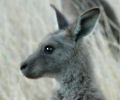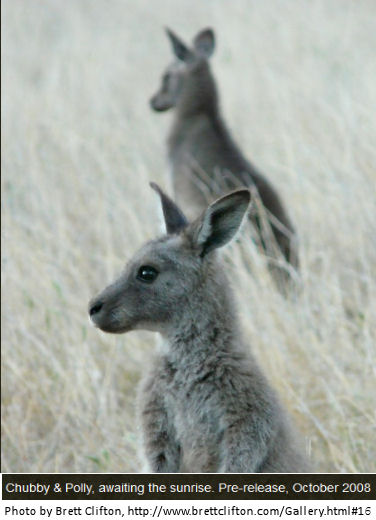Baby kangaroos dying at unusual rate in ACT & NSW from unknown disease - Article by Helen Stevens
 Over the last few months there has been an alarming increase in the numbers of juvenile Eastern Grey Kangaroo's being found either dead or in a very lethargic state and near death in parts of the ACT and adjacent New South Wales. Rosemary and Steve Garlic, who are wildlife carers in the area, were initially contacted by a few Wildcare carers and the issue then seemed to be centred around the Wamboin/Norton Road area. This article was developed from an internal note to members of Wildcare, of which Steve and Rosemary Garlic are members and Helen Stevens is the coordinator.
Over the last few months there has been an alarming increase in the numbers of juvenile Eastern Grey Kangaroo's being found either dead or in a very lethargic state and near death in parts of the ACT and adjacent New South Wales. Rosemary and Steve Garlic, who are wildlife carers in the area, were initially contacted by a few Wildcare carers and the issue then seemed to be centred around the Wamboin/Norton Road area. This article was developed from an internal note to members of Wildcare, of which Steve and Rosemary Garlic are members and Helen Stevens is the coordinator.
 The situation now seems to be far more widespread as Wildcare have now received sick animals from Queanbeyan NSW, Jerrabomberra NSW, the ACT, Sutton NSW, and this week Burra, near Queenbeyan. Between Rosemary/Steve and myself we have dealt with or known of 60 suspected cases and it is very distressing.
The situation now seems to be far more widespread as Wildcare have now received sick animals from Queanbeyan NSW, Jerrabomberra NSW, the ACT, Sutton NSW, and this week Burra, near Queenbeyan. Between Rosemary/Steve and myself we have dealt with or known of 60 suspected cases and it is very distressing.
The animals affected appear to be last years offspring ranging from 8kgs to 18kgs. They are either being found dead, with no appearance of injury, in paddocks etc or are showing signs of weight loss, lethargy allowing them to be rescued easily and are hypothermic.
All that have come into care have died, usually between 1 and 24 hours later despite all our efforts as well as medical attention. Contrary to what some believe, it is not starvation due to over population as they are usually still eating and passing normal faeces and post mortem has shown digested food in the stomach and formed pellets in the intestine.
Wildcare are working closely with NPWS, DPI, Australian Registry for Wildlife Health and some of our local vets to try to identify the cause of this unusual occurance and the situation has been escalated to an alert as some national parks in the ACT are recording very high numbers too.
A number of deceased animals have been transported to Sydney for further examination and testing but at the moment results have been unable to identify what is causing the fatal decline in these joeys.
Upon post mortem the 5 animals that have been examined by our local wildlife vet Dr Howard Ralph, and the vets at DPI and the Taronga Conservation Society have all shown fluid in the peritoneal cavity (ascites) and some showing fluid around other major organs.
The majority seem to have a very high number of nematodes (worms) in the intestine but the question is still "why" as parasites will increase if an animal's immune system is compromised.
We are not seeing young in pouch joeys, who would be receiving antibodies via their mothers milk, or adults, who have developed immune systems, affected.
Investigations are looking at possible virus, parasite/protozoa infestation, transmission by ticks (as in Babesia), plant poisoning etc. So far post mortem results have been negative for Babesia and Phyllaris grass poisoning (hundreds of kangaroos are dying from this in Victoria around Bendigo, Kilmore and Broadford) but more testing is needed to compare cases and to continue to try to find a common cause which will hopefully lead to a treatment path if the animal is viable.
What can you do to help?
Not only do we need to document any possible cases but we require more testing to be carried out by the NPWS suggested agencies.
Please let Wildcare know asap if
a) you come across an animal that appears to be affected - they will usually be alone, appear underweight, may have aeroplane (floppy) ears and do not try to escape/move off if approached;
b) you find a fresh deceased juvenile kangaroo that appears to have no external injury;
c) your friends/neighbours mention finding a number of young kangaroo bodies over the last few months.
If I receive any news regarding possible diagnosis I will send out an update as I know many are very worried about this.
Source: Helen Stevens, Wildcare Macropod Co-ordinator, Oolandra Wildlife Sanctuary, 02 62991966

Recent comments